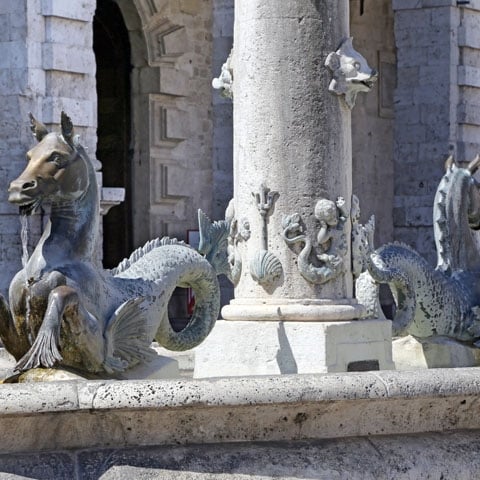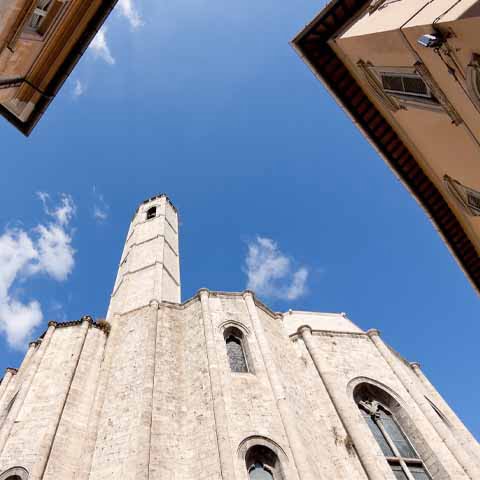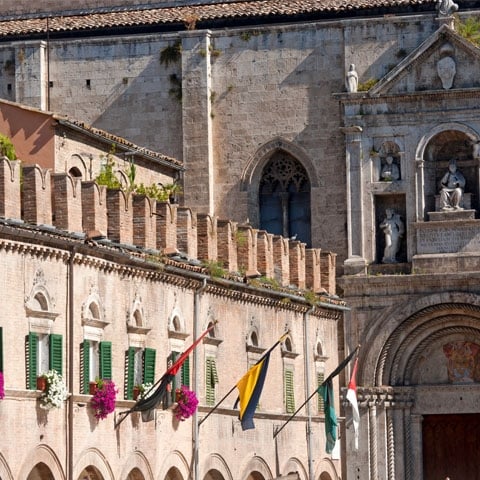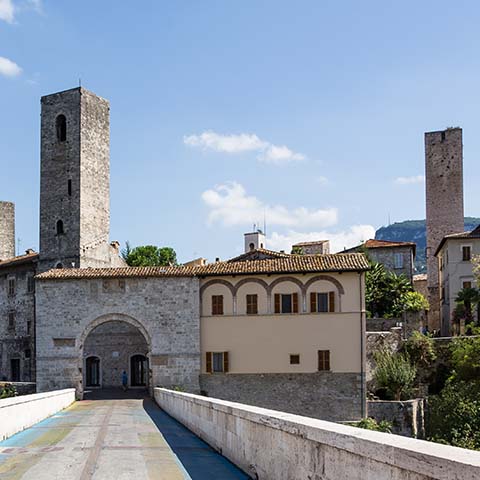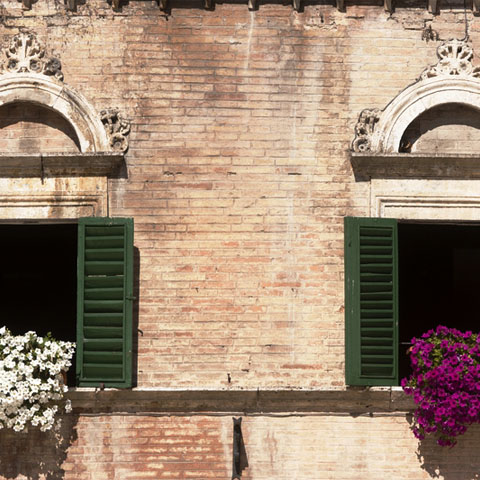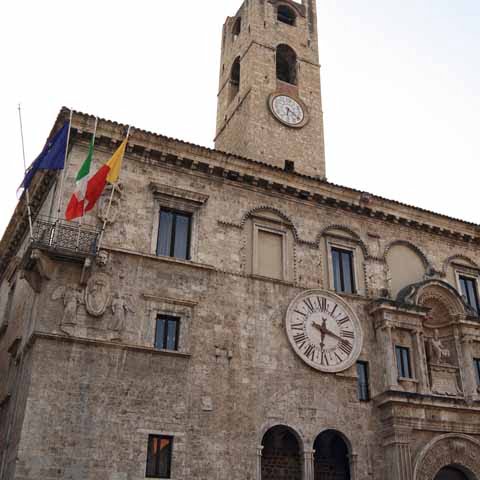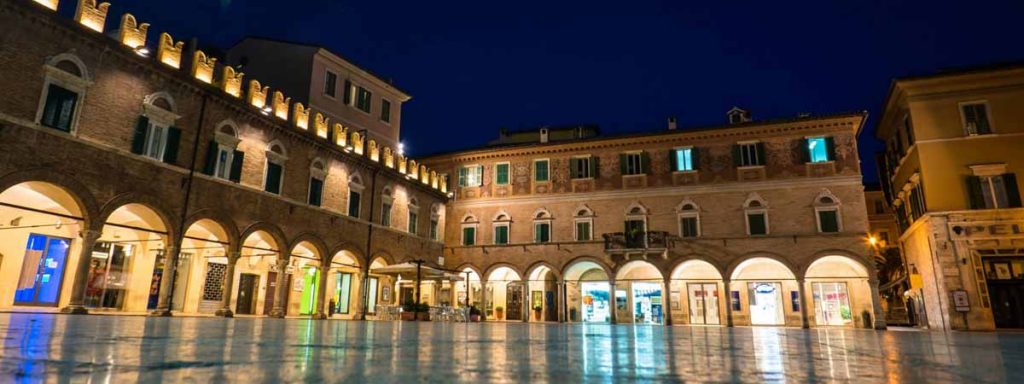Ascoli Piceno, the fifth largest city in the Marche region of Italy and the capital of the homonymous province, impresses with a rich and tumultuous history. It has the largest historic center in Marche, built almost entirely in travertine. Furthermore, this city is among the most admired in Central Italy.
By virtue of its artistic and architectural wealth, Ascoli Piceno attracts thousands of visitors each year. It preserves several noble dwellings and towers, edifices that gained it the nickname “The City of a Hundred Towers.”
Perhaps the main landmark of this beautiful settlement is Piazza del Popolo, a Renaissance square that preserves most of its original beauty.
Over time, the city has been identified with its Greek-Roman name, Asculon. The term Picenum was introduced by Julius Caesar, who called it Asculum Picenum to distinguish it from the homonymous city in Apulia, now known as Ascoli Satriano, and to identify its position in the Picenum Suburbicarium region.
PREHISTORY OF ASCOLI PICENO
Like most settlements in Italy, Ascoli Piceno impresses with a long history. The oldest traces of human presence in the area date back to the Paleolithic Age, although the evidence of this era is rather scarce.
Stable settlements were attested to since the Neolithic and the Metal Age. During these periods, people in the region dedicated themselves to agriculture and breeding.
The true origins of the city are shrouded in mystery, and some historians claim it was a Sabine population that settled in the area for the first time.
Strengthened by its geographical position between the Tronto and Castellano Rivers, Ascoli Piceno gradually assumed importance.
In 268 BC, the settlement found itself divided between Piceno, a fraction that entered in the Roman area of influence, and Ascoli, which managed to preserve its independence despite being forced to accept the statute of civitas foederata.
However, the Romans did not have a strong interest in the area and did not focus on its development until the beginning of 91 BC, when the Social War broke out. The Italic peoples rose against the supremacy of Rome, and Ascoli played such a significant role that it marked its importance in the Empire.
As a result, the settlement claimed Roman citizenship and the right to participate in the administration of the Empire.
However, the Italic populations murdered the Roman proconsul as well as all Roman citizens who entered the city, events that caused Rome to accuse Ascoli of plotting against the Roman aristocracy.
These events marked the beginning of hostilities between Rome and Ascoli, causing the slaughter of many citizens in the Roman theater during a show.
This tragic event unleashed the reaction of Rome who delegated Pompey Strabo as leader of an army set against Ascoli.
After a long siege lasting for over two years, Ascoli fell under the weapons of the enemy, mainly because of the evident disparity of forces favorable to Rome.
Under Imperial Rome, Ascoli rose more splendidly than ever. Testimonies from the era show evidence of many Roman monuments, including the Gemina Gate and the Cecco Bridge as well as the remains of the Roman theater and amphitheater, and two ancient temples now incorporated in the Churches of San Gregorio and San Venanzio.
HISTORY OF ASCOLI PICENO
Ascoli Piceno gained so much importance in the Roman era that it became the seat of the governor of Picenum Suburbicarium in 301 AD. In the same year, the clergy also established their important role in the city thanks to Sant’Emidio who managed to gain undisputed spiritual authority in a very short time.
With the arrival of the barbarians, Ascoli entered into a sensible economic and intellectual decadence with widespread growing misery. Life in the region was reduced to an economy of subsistence under the protection of the church.
Nevertheless, the city managed to defend itself from the Visigoths, who, faced with imposing city walls and the priceless natural defense provided by the rivers, decided to retreat and leave the settlement in peace.
This fortunate situation changed though with the arrival of the Goths who, after having occupied all the settlements in the countryside, besieged the city.
In 553, after the defeat of Totila, the city passed under the rule of Ravenna, with the power being assigned to an archduke, but exercised by a bishop.
The grim times continued throughout the century with the arrival of the Lombards who slaughtered the locals, destroyed churches and defensive edifices, and razed the city walls to the ground.
In 593, Queen Theodelinda started the reconstruction of the city and its castles, besides welcoming the return of the fugitives. Ascoli became part of the territory of the Duke of Spoleto, where it stayed for the next two centuries.
At the same time, Gregory the Great managed to convert the Lombard court to Catholicism, obtaining significant results in mitigating the contrasts and the aversion of the locals towards the dominating power.
By the end of the seventh century, clergy became increasingly important not only from a religious but also from a political point of view. The interference of the bishops with the government widened considerably, slowly pushing the Duke away.
The end of the Lombard domination was completed in 789 when Ascoli became a county protected by the pontiff and ruled by a count assisted by local nobility.
Under the influence of Charlemagne, Ascoli was raised to the rank of the county seat of the Holy Roman Empire, obtaining a special legal status due to its strategic position. In fact, the count could easily reach Rome from here by passing through Salaria or the Duchy of Benevento.
Under the bishops’ rule, Ascoli received many defensive edifices, including 82 watchtowers and some bridges, which shaped the urban aspect of the city into the Middle Ages.
However, not all locals agreed with the power and internal disorders led to struggles between the partisans of the empire and the pope, which only ended with the nomination of the Guelph Lothair as Count.
The succession to the throne of the Ghibelline Corrado III complicated the situation again, but the church managed to dominate the contending parties, elevating the bishops to the position of prince. In fact, even today the bishops of Ascoli preserve the right to be called princes.
But this situation did not last for long due to the arrival of Barbarossa. Under his rule and with the death of Bishop Gisone in 1183, Ascoli received its first Podestà. A municipal government established itself in the city, bringing to an end the secular power balance between the bishops and the counts. These events laid the basis of a communal regime that served the pope.
Ascoli received Henry II with great pride and in 1225, St. Francis arrived in the city with the intent to preach peace. He established the first convent in the region, counting over thirty clerics and laity.
However, the emperor did not tolerate the new Guelph power and sent Frederick II to occupy Ascoli and re-establish obedience.
The troops of Frederick brought destruction to the city, including the demolition of 90 towers. At the same time, the consuls were imprisoned, the bishop was banned, and the Guelphs were killed in the massacre.
The new Ghibelline power was granted with privileges by the Emperor, to the detriment of Fermo, a city controlling the entire Adriatic coast between Potenza and Tronto. This triggered long wars between the two cities until the first half of the sixteenth century.
Over all those years, the hostilities between Ascoli Piceno and Fermo were so frequent and habitual that they were considered a sort of natural disaster by the inhabitants.
The beginning of the fourteenth century came with a short period of peace, interrupted in 1323 when Ascoli, fearing that Avignon was planning to take control of their possessions, invaded Fermo, slaughtering most inhabitants.
After a period of fierce battles, Ascoli managed to regain its republic, but only enjoyed the victory for a short time until the arrival of count Francesco Sforza in the region. The latter, elected by the pontifical vicar of the Marche, set up his seat in Ascoli.
The city established good commercial and political relations with Venice, Naples, Florence, Genoa, and Rome during the fifteenth and sixteenth centuries, knowing a true cultural renewal during the Renaissance.
Over this time, many important historical edifices were built alongside other urban works.
Ascoli managed to free itself from the Sforza and regain the republican order in 1482. However, the new acquired ecclesiastical liberties turned out to be an expensive affair, as the city had to pay an annual tribute to the Pope.
In the meantime, the struggles between the Guelphs and the Ghibellines put new burdens on the city.
Taking advantage of the events, the noble family of Guiderocchi managed to acquire a despotic power endowed in two bodies, the Council of the Nobles and the Council of the People. The new tyrannical power went so far as to not accept the peace concluded with Fermo, which led to popular uprisings that concluded with the exile of the Guiderocchi.
However, the internal wars continued, and the conspiracies became denser and denser until Pope Paul III decided to step in and put an end to the struggles.
The second half of the sixteenth century found Ascoli Piceno destroyed by banditry, brigands, and rebels who found cruelty to be the only system of survival.
The clergy decided to step in and establish a peculiar custom allowing anyone to kill a bandit, granting privileges and money to those involved in fighting against the phenomenon. This was one of the saddest periods for Ascoli.
At the same time, on the orders of the pontiff, a fortress was erected, while the elevation to the throne of Sisto V brought some order to the government and local administration.
The beginning of the seventeenth century brought some peace to Ascoli, and the city became the capital of an exclusively agricultural area. New social figures were born, and people could now find work, food, and lodging.
This marked the beginning of a period of peace for the city characterized by a quiet life lived between the two fortresses that the lords and the popes built around the city over the centuries.
Many nobles unwilling to endure the long peace preferred to leave Ascoli, putting themselves at the service of Venice, France, Spain, and Austria. The city knew no threats nor wars of any kind during this period, but only the passage of some foreign troops.
Life continued without disturbance while the city followed the examples of Florence and Venice in promoting decentralized agriculture. With the French revolution, Ascoli suffered from foreign invasions that concluded with riots.
In 1798, the General Council of Ascoli decreed the democratization of the local government, giving equal parts of the decisional power to nobles, merchants, and peasants, and establishing a new civic guard.
The uprising against the revolution was general, although the famous Giuseppe Costantini managed to lead some insurrectional movements and gave life to banditry once again.
These formations entered Ascoli in 1799, followed by skirmishes and tumults that widened from Ascoli up to Tronto, with a favorable outcome for the republic. However, towards the middle of the same year, the French succeeded to gain control over the city.
A period of political confusion, frightful anarchy, and the rise of insurrectional bands followed.
At the beginning of the nineteenth century, Napoleon united Ascoli with Fermo and Camerino into a single province, the Department of Tronto. The city, thus, became the southernmost part of the Kingdom of Italy, subordinate to Fermo.
With the fall of Napoleon, the municipal authorities, as well as the locals, welcomed the restoration of the papacy in the region.
The change did not bring vengeance nor bloodshed, but only institutional changes in which the canonical law replaced the Roman one, the national guard replaced the provincial guard, and the old guards were replaced with the church’s trusted people.
Ascoli received the proclamation of the Republic with strong sympathy. During his journey to Rome, Garibaldi passed through Ascoli, arising great enthusiasm among the population. The city followed the Italian freedom movements with great passion.
After the Unification of Italy in 1860, Ascoli was given back its primitive fraction, Piceno, and became the capital of the new homonymous province. From then on, the history of Ascoli Piceno intertwined with the history of Italy.
Today, Ascoli Piceno is one of the Marche region’s cultural hubs offering plenty of sites for international travelers to admire.
ARCHAEOLOGY IN ASCOLI PICENO
Inhabited since the earliest times, Ascoli Piceno preserves much of its Roman and Medieval history.
Some noteworthy open-air sites include the Roman theater as well as the remains of the Roman amphitheater, a Roman gate, and remains of some Roman roads. From the Middle Ages, visitors can admire numerous buildings and defensive edifices, including bridges, towers, and city walls.
The National Archaeological Museum of Ascoli Piceno also houses an important collection of vestiges and artifacts found scattered throughout the territory. One famous artifact is an emblematic polychrome mosaic with a central mask, now exhibited in the museum.
Don't just see Italy, live it.
Your dream trip to Italy has never been closer
No more endlessly scrolling travel sites. Our travel experts will craft the perfect, one-of-a-kind trip just for you.

300+
DESTINATIONS
We offer more Italian destinations than any travel site. Do and see more with Trips 2 Italy.
1 (of a kind)
ITINERARIES
Because your dream trip to Italy should be designed for you, not for the masses.
100%
PEACE OF MIND
From flights and accommodations, to food and activities - we take care of every detail.
